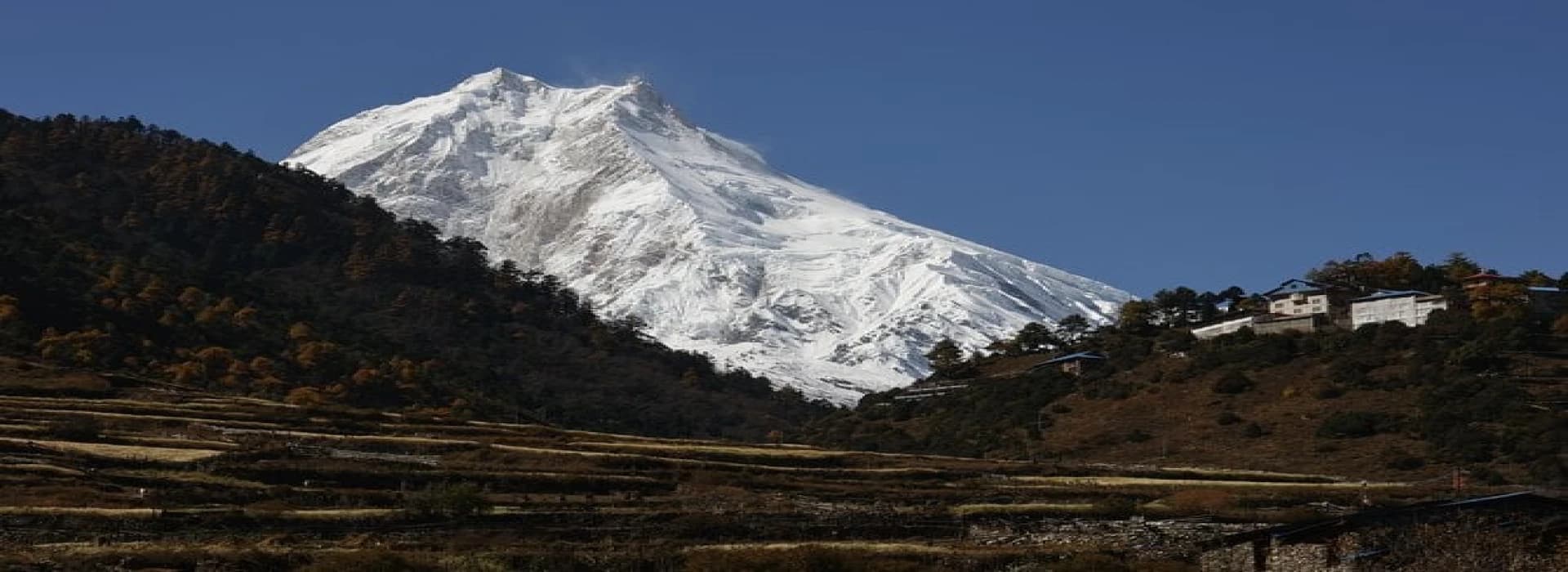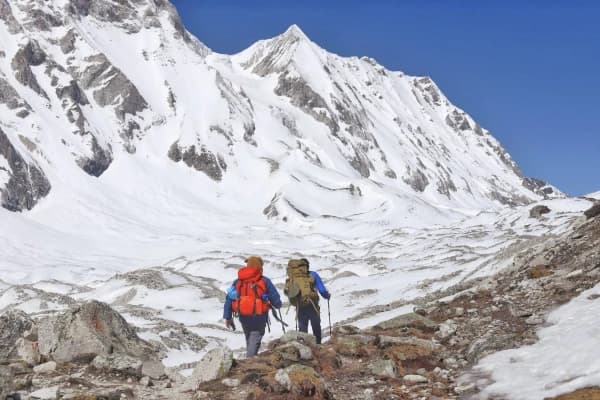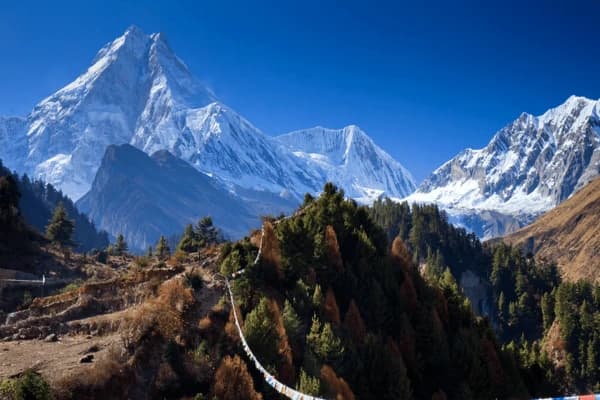It's always crucial to understand the difficulty level and success rate of the trek you're planning to undertake in the coming days. Even if you're an experienced trekker, you should be aware of such things before you leave your home to test your threshold.
If the Manaslu Trek is on your bucket list, you might want to learn about its success rate and other important details before planning your adventure. Consequently, I'm writing this blog 'Manaslu Circuit Trek Success Rate: What You Need to Know' for you, which will help you get well-prepared for this expedition.
Just because you found the Manaslu Region beautiful and perfect for creating reels, TikTok videos, vlogs, and taking pictures, you cannot just neglect the possible difficulties ahead on the trail that you might face. During the trek, it is all a fun game until some random problem comes your way.
You will be aware of the difficulty level, travel duration, potential difficulties, and success rate of the Manaslu 12 days Trekking, as well as key factors to consider for a successful experience, through this blog today. Spare some time for yourself to read the blog til the end. I bet you that you'll find the courage for this trip if you're a beginner and want to take a risk for the beautiful reward that awaits you afterwards.
Manaslu Circuit Trek Success Rate
Before we delve directly into the success rate of the Manaslu Circuit Trekking, I'd like to provide a brief overview of its difficulty level, duration, major attractions, and popularity. It'll be much better for us if we learn the basic things about this adventure first.
The trek is considered moderate to challenging and walking at a normal pace, it takes typically 12-14 days to conclude. Some of its major attractions that draw the attention of adventure lovers worldwide are as follows:
- Tibetan Buddhist culture and traditions
- Nubri Monastery and Pungyen Monastery
- Home to endangered species, such as Himalayan Tahr, snow leopard, blue sheep, etc.
Exceptional views of the peaks, such as Mt. Manaslu (8,163 m/26,781 ft), Manaslu North (8,163 m/26,782 ft), Ganesh Himal (7,422 m/24,350 ft), and other neighbouring peaks.
Larke Pass (5,106 m/16,752 ft), the highest point of the trek and also, the longest pass in Nepal.
Budhi Gandaki River.
Speaking of the Manaslu Circuit Trail's popularity, it is beautiful and famous not as much as the other treks, such as Everest Base Camp Trek, Annapurna Base Camp Trek, Mardi Himal Trek, Annapurna Circuit Trek, etc., though. Therefore, it's still viewed as an off-the-beaten path.
This trek is currently ideal for those who prefer a silent journey to a commercial one. Even during peak seasons: spring (March to May) and autumn (September to November), there's no huge traffic along the route, allowing you to immerse in the wild peacefully.
So, these are some basic things about the Manaslu Circuit Trek. Now, regarding its success rate, it is generally as high as 98%, which is almost 100% despite being a demanding trek in the country. This is because there are plenty of hotel businesses operated by the locals along the way, making your journey convenient.
Most of them are equipped with modern amenities, such as WiFi connection, electricity, and hot showers. Besides, they also have a variety of food options available on the menu, including Western cuisines.
In terms of the entire trail, the way from the typical starting point, Machha Khola (930 m/3051.18 ft) to Namrung (2,630 m/8,629ft) is a bit technically hard, as you'll need to pass through some landslide areas. However, don't get panicked so fast. It ain't that hard or risky to walk.
If it was really that extreme, then the success rate wouldn't be almost 100%. All you need to do is hike calmly and carefully. After Namrung, the route is easy for you.
How to boost your Manaslu Circuit Trek Success Rate?
Just because you've now discovered that Manaslu Circuit Trekking has a high success rate despite it being considered moderate to challenging in difficulty doesn't mean it can be done without being serious. Easy or hard, it does not matter.
Whenever it comes to trekking, you must always be serious about your journey because your single carelessness can cause you a huge loss. You can even lose your life during this trek if you aren't acting smart.
There are a few other aspects that contribute to the high success rate of the Manaslu Round Trek apart from the accommodation facilities and less technical route. They are:
Well-Preparation:
To complete this trek, it's important to be healthy and physically prepared. Even if you're going through a normal cough, you better not go out for this adventure until you're 100% fit and fine, especially if you're a first-timer.
If you're a non-workout person, I suggest you start doing workouts at least a couple of weeks before your date of trekking. Exercises such as stretching, running, and squatting are regarded as the best for trekking purposes.
Furthermore, before leaving for this adventure, just make sure that you have packed all the appropriate gear for trekking, including footwear, clothing, and other things that are necessary for your protection and convenience. Every small thing is valuable and plays a crucial role on a trek. Thus, forgetting any single piece of equipment could be a mess for you.
Read: Preparation For The Manaslu Circuit Trek
Acclimatization:
You should also have proper knowledge about acclimatization. You shouldn't rush while ascending. To prevent altitude sickness, you should walk slowly and take a break of at least 7 to 8 minutes frequently while hiking because the slower you walk and take a break whenever you feel uneasy, the more you get familiar with the air of the Manaslu Region.
Additionally, when you finally make it up to 3,000 m (9,843 ft), it's necessary to spend an extra day in the same place. Doing so will help your body to acclimatize properly. For this trek, Sama Gaun (3,520 m/11,549 ft) is an amazing village with a huge settlement that is commonly used for acclimatization day by trekkers.
Experienced Guide Or Porter:
For trekking the Manaslu Circuit, you'll need to hire a guide, porter, or both (if required), as the entire trail lies in a restricted area. As a result, their company is compulsory for foreigners. To hire them, you'll need to go through the local tour operator.
They can provide you with an experienced guide or porter who can take care of you and your belongings. One of the best in this business is the Ammonite Adventure, located in Thamel, Kathmandu. They can arrange your entire program, making your trip hassle-free.
Even if it's not mandatory to hire a local guide or porter, an independent trek is risky in Nepal's Himalayas. There have been many cases where independent hikers lost their lives.
It's great to have proper knowledge about the destination you're travelling to shortly. However, you'll be thoroughly on your own, and at high elevations, risk is always very high.
If you hire a local guide, they'll take care of you throughout your journey. If you suffer from altitude sickness or get injured, they will arrange to bring you down immediately and also, help you learn about the Manaslu Region during the trip. Hence, trekking with them gives you an almost 100% chance of finishing this journey successfully.
Picking The Right Season:
To complete this trek successfully, it's essential to know about the best season first. There are two seasons recognized as the best time to trek in the Manaslu Region and they are spring and autumn, which I have also mentioned already.
Both seasons offer you stable weather and clear skies, allowing you to enjoy the beauty of Nepal's Himalayas. The other two seasons: Winter (December to February) and Monsoon (June to August) are not preferable for adventure, especially the rainy season.
Read: Best Time To Trek The Manaslu Circuit
Eat Well:
You shouldn't compromise on eating food. During trekking at high elevations, we sometimes feel lazy and low due to exhaustion. We'll starve for sure after ascending for 5 to 6 hours.
Yet, at the same time, we don't wanna eat much, instead, we wanna hit the bed as soon as it is possible. Doing so will take you close to high-altitude sickness shortly. Therefore, no matter how tired you will feel upon reaching your destination for an overnight stay, you'll eat until you get full.
Consuming carbohydrate foods like rice, pasta, and potatoes will get you the best result while trekking the Manaslu Circuit because food like these is heavy and takes a long time to digest. The longer the food remains in your body, the longer your body stays energized, and the more distance you'll be able to cover.
Likewise, you will also be able to prevent any circumstances related to altitude sickness. In addition, it's better if you avoid over-fried, oily, and non-veg items during the trek, as it may cause you food poisoning. If you're fond of drinking alcohol and smoking cigarettes, you should avoid it too, at least during the trek.
Stay Hydrated:
Always drink water at least 3 to 4 litres a day whether you're trekking at high altitude locations like the Manaslu Region or just living regular life in your hometown. Anyway, here we're discussing the success rate of the Manaslu Circuit Trek. So, in order to make it successful, you should be serious about staying hydrated during this journey.
While hiking for a long time under the sunlight, no wonder, your body gets sweaty and that's where you lose a lot of water. Hence, you'll need to drink no less than 3 litres of water a day during trekking to keep your distance from altitude sickness. Apart from this, you should also consider eating foods with high amounts of water like watermelon, cucumber, and apple.
Altitude sickness is one of the most common possible difficulties that you may suffer while hiking at high elevations. A mild headache is one of the primary symptoms of it and others are lack of appetite, nausea, trouble sleeping, etc.
Drawing from my experience, I have faced a situation where I was the victim of high-altitude sickness due to my carelessness. I didn't bother to drink much water at that time and suffered mild headaches continuously for five days and couldn't finish my expedition. Therefore, you should take this matter seriously and keep yourself hydrated at all times during the Manaslu Trek.
Summary
Despite being moderate to challenging in difficulty level, the Manaslu Circuit Trek still has a success rate of over 98%. The major aspects of such a fine record are accommodation facilities along the trail and less technical routes.
However, it doesn't mean that you can easily pass through its highest and main point which is the Larke Pass, sitting at an altitude of 5,106 m (16,752 ft). It generally takes 14 days to conclude by walking at an average pace and hiking for such a long duration can definitely make you feel this trek tough if you're a beginner.
Accordingly, if you want to enjoy this adventure to the fullest by witnessing the real face of Nepal's Himalayas along the way, then there are also a few other factors that contribute to its high success rate apart from the major aspects that are stated earlier. They are listed below:
- Health conditions should be 100% okay.
- Start working out at least a month before your trekking date if you ain't a regular exercise person. Exercises, such as stretching, running, and squatting are best for trekking.
- Pack all the appropriate gear for trekking, including footwear, clothing, and other things that are necessary for your safety and comfort.
- Walk slowly and take frequent breaks of at least 7 to 8 minutes while hiking and spend an extra day once you reach up to 3,000 m (9,843 ft) to acclimatize your body. Sama Gaun (3,520 m/11,549 ft) is a typical place for acclimatization for this trek.
- Hire a local guide or porter, as they'll take full responsibility for you and in case you suffer from altitude sickness or get injured, they will bring you down to safety immediately. Also, it's compulsory to hire them because the entire trail is considered a restricted area.
- Choose the right season for the trek. Spring (March-May) and autumn (September-November) are rewarded as the best time to trek.
- Eat foods like rice, potatoes, and pasta during trekking. They contain high levels of carbohydrates that provide you with energy for a long time and keep you away from suffering altitude sickness.
- Don't let your body go dehydrated. Drink at least 3-4 ltr of water during your trek to prevent altitude sickness.
Might be interest: Manaslu Circuit Trekking vs Annapurna Circuit Trekking






